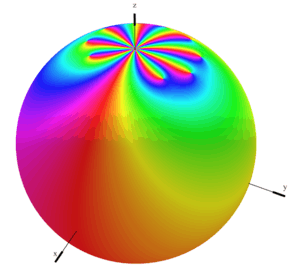Pole (complex analysis)

In the mathematical field of complex analysis, a pole of a meromorphic function is a certain type of singularity that behaves like the singularity of at z = 0. For a pole of the function f(z) at point a the function approaches infinity as z approaches a.
Definition
Formally, suppose U is an open subset of the complex plane C, p is an element of U and f : U \ {p} → C is a function which is holomorphic over its domain. If there exists a holomorphic function g : U → C, such that g(p) is nonzero, and a positive integer n, such that for all z in U \ {p}
holds, then p is called a pole of f. The smallest such n is called the order of the pole. A pole of order 1 is called a simple pole.
A few authors allow the order of a pole to be zero, in which case a pole of order zero is either a regular point or a removable singularity. However, it is more usual to require the order of a pole to be positive.
From above several equivalent characterizations can be deduced:
If n is the order of pole p, then necessarily g(p) ≠ 0 for the function g in the above expression. So we can put
for some h that is holomorphic in an open neighborhood of p and has a zero of order n at p. So informally one might say that poles occur as reciprocals of zeros of holomorphic functions.
Also, by the holomorphy of g, f can be expressed as:
This is a Laurent series with finite principal part. The holomorphic function (on U) is called the regular part of f. So the point p is a pole of order n of f if and only if all the terms in the Laurent series expansion of f around p below degree −n vanish and the term in degree −n is not zero.
Pole at infinity
A complex function can be defined as having a pole at the point at infinity. In this case U has to be a neighborhood of infinity, such as the exterior of any closed ball. To use the previous definition, a meaning for g being holomorphic at ∞ is needed. Alternately, a definition can be given starting from the definition at a finite point by suitably mapping the point at infinity to a finite point. The map does that. Then, by definition, a function f holomorphic in a neighborhood of infinity has a pole at infinity if the function (which will be holomorphic in a neighborhood of ), has a pole at , the order of which will be regarded as the order of the pole of f at infinity.
Pole of a function on a complex manifold
In general, having a function that is holomorphic in a neighborhood, , of the point , in the complex manifold M, it is said that f has a pole at a of order n if, having a chart , the function has a pole of order n at (which can be taken as being zero if a convenient choice of the chart is made). ] The pole at infinity is the simplest nontrivial example of this definition in which M is taken to be the Riemann sphere and the chart is taken to be .
Examples

- The function
- has a pole of order 1 or simple pole at .
- The function
- has a pole of order 2 at and a pole of order 3 at .
- The function
- has poles of order 1 at To see that, write in Taylor series around the origin.
- The function
- has a single pole at infinity of order 1.
Terminology and generalizations
If the first derivative of a function f has a simple pole at a, then a is a branch point of f. (The converse need not be true).
A non-removable singularity that is not a pole or a branch point is called an essential singularity.
A complex function which is holomorphic except for some isolated singularities and whose only singularities are poles is called meromorphic.
See also
- Control theory#Stability
- Filter design
- Filter (signal processing)
- Nyquist stability criterion
- Pole–zero plot
- Residue (complex analysis)
- Zero (complex analysis)